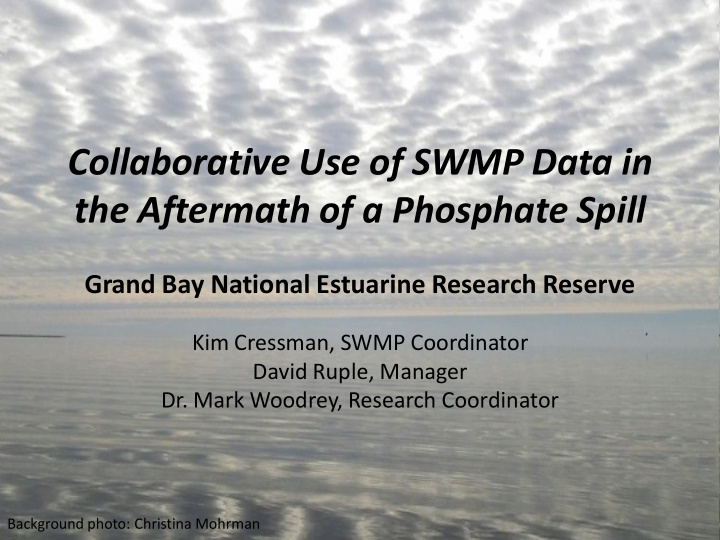



Collaborative Use of SWMP Data in the Aftermath of a Phosphate Spill Grand Bay National Estuarine Research Reserve Kim Cressman, SWMP Coordinator David Ruple, Manager Dr. Mark Woodrey, Research Coordinator Background photo: Christina Mohrman
Grand Bay NERR • Established 1999 • State Partner: MS Dept. of Marine Resources (DMR) • ~18,400 acres • System is: – Shallow Phosphate – Marine- Plant dominated – Micro-tidal Bangs Lake Bayou Casotte
The Setting: April 2005 • SWMP Monitoring: – Water Quality stations running since January 2004 – First Nutrient sampling March 2005 • Very rainy spring led to a discharge into Bayou Casotte Photo: Chris May
The start of the problem in Bangs Lake • Phone calls about dead fish alerted NERR and DEQ to problem • First DEQ visit to Bangs Lake was 4/18, which was days after the spill. Photos: MS Department of Environmental Quality • Eventual estimate of >100,000 fish and blue crabs killed.
The Spill: Aerial View Direction of drainage N Photo : Chris May
Timing of the spill determined using SWMP pH data
Coordination Between Agencies • DEQ had regulatory authority and was the lead agency • DMR Fisheries and NERR staff: – Provided local expertise – helped determine extent of damage – Assisted in fish counts, site evaluations, resource valuation • NERR staff provided data directly to DEQ • In-person meetings were held on the coast and in Jackson • By all accounts, agencies worked well together
298 acres of oyster habitat damaged Graphic : MS Department of Marine Resources
Photos : Chris May Algae Blooms
Vegetation Damage Photo: Chris May
Photos: Chris May Estimates of vegetation loss: – 25 acres browned initially – 15 acres killed
Summary of Damages Information from MS DMR • Total monetary loss of resources ~ $2.6 million – >100,000 fish and blue crabs killed, and this is likely an underestimate – 298 acres of oyster growing areas damaged – 15 acres of marsh lost • Decrease in number of crab traps and recreational fishermen on the water for 3-4 months after spill
Uses of SWMP Data - 2005 Event • By DEQ: – Pinpointed timing of incident – Indicated when contaminant levels returned to normal • Educational activity in the High School Estuaries 101 Physical Science curriculum Hurricane Katrina
Uses of SWMP Data (Generally) • Signal problematic events – Real-time data can alert staff to a problem – Determine whether an event is acute or ongoing – Allow for more intense sampling if needed • Provide context for incidents • Encourage collaboration • Recent data has led to productive interactions with fellow researchers Photo: Grand Bay NERR and DEQ
Resolution of 2005 Spill • January 2008: Phosphate company and MS DEQ entered into Agreed Order • Fines and assessments led to: – Real-time telemetry system with data alerts – Bangs Lake North NUT station – Additional fine put toward sewer connections in Jackson County • Improvements in Phosphate Company management, oversight, and storm preparations – Raised levee – Caustic material now kept on-site – Geotextiles now kept on-site – DEQ stays in contact when storms are approaching
Lessons Learned • Local Expertise is key Top photo: • Data matters Christina – Baseline monitoring Mohrman – Timing is important Bottom – Quality! QAPP if necessary photo: Chris May • Build relationships early – know who you need to talk to – Regulatory agency – Collaborators at other institutions
Questions? Photo: Christina Mohrman
Recommend
More recommend